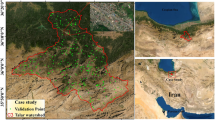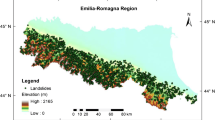Abstract
Hurricanes can severely damage the electric power system, and therefore, predicting the potential impact of an approaching hurricane is of importance for facilitating planning and storm-response activities. A data mining approach, classification and regression trees (CART), was employed to evaluate whether the inclusion of soil and topographic variables improved the predictive accuracy of the power outage models. A total of 37 soil variables and 20 topographic variables were evaluated in addition to hurricane, power system, and environmental variables. Hurricane variables, specifically the maximum wind gust and duration of strong winds, were the most important variables for predicting power outages in all models. Although the inclusion of soil and topographic variables did not significantly improve the overall accuracy of outage predictions, soil type and soil texture are useful predictors of hurricane-related power outages. Both of these variables provide information about the soil stability which, in turn, influences the likelihood of poles remaining upright and trees being uprooted. CART was also used to evaluate whether environmental variables can be used instead of power system variables. Our results demonstrated that certain land cover variables (e.g., LC21, LC22, and LC23) are reasonable proxies for the power system and can be used in a CART model, with only a minor decrease in predictive accuracy, when detailed information about the power system is not available. Therefore, CART-based power outage models can be developed in regions where detailed information on the power system is not available.




Similar content being viewed by others

References
Breiman L, Friedman RA, Olshen RA, Stone CJ (1998) Classification and regression trees. Chapman and Hall/CRC, New York
Davidson RA, Liu H, Sarpong IK, Sparks PR, Rosowsky DV (2003) Electric power distribution system performance in Carolina hurricanes. Nat Hazards Rev 4:36–45
Guikema SD, Quiring SM, Han SD (2010) Prestorm estimation of hurricane damage to electric power distribution systems. Risk Anal 30:1744–1752. doi:10.1111/j.1539-6924.2010.01510.x
Han SR, Guikema SD, Quiring SM (2009a) Improving the predictive accuracy of hurricane power outage forecasts using Generalized Additive Models. Risk Anal 29:1443–1453
Han SR, Guikema SD, Quiring SM, Lee KH, Rosowsky DV, Davidson RA (2009b) Estimating the spatial distribution of power outages during hurricanes in the Gulf Coast region. Reliab Eng Syst Saf 94:199–210
Kupfer JA, Myers AT, McLane SE, Melton GN (2008) Patterns of forest damage in a southern Mississippi landscape caused by Hurricane Katrina. Ecosystems 11:45–60
Liu H, Davidson RA, Rosowsky DV, Stedinger JR (2005) Negative binomial regression of electric power outages in hurricanes. J Infrastruct Syst 11:258–267
Liu H, Davidson RA, Apanasovich TV (2007) Statistical forecasting of electric power restoration times in hurricanes and ice storms. IEEE Trans Power Syst 22:2270–2279
Liu H, Davidson RA, Apanasovich TV (2008) Spatial generalized linear mixed models of electric power outages due to hurricanes and ice storms. Reliab Eng Syst Saf 93:875–890
McKee TB, Doesken NJ, Kleist J (1993) The relationship of drought frequency and duration to time scales. In: Preprints, 8th conference on applied climatology. AMS, Anaheim, CA, pp 179–184
McKee TB, Doesken NJ, Kleist J (1995) Drought monitoring with multiple time scales. In: Preprints, 9th conference on applied climatology. AMS, Dallas, TX, pp 233–236
Willoughby HE, Rahn ME (2004) Parametric representation of the primary hurricane vortex. Part I: observations, evaluation of the Holland (1980) model. Mon Wea Rev 132:3033–3048
Willoughby HE, Darling RWR, Rahn ME (2006) Parametric representation of the primary hurricane vortex. Part II: a new family of sectionally continuous profiles. Mon Wea Rev 134:1102–1120
Zhao M, Escobedo FJ, Staudhammer C (2010) Spatial patterns of a subtropical, coastal urban forest: implications for land tenure, hurricanes, and invasives. Urban For Urban Green 9:205–214
Acknowledgments
This work was partially funded by a private utility company that wishes to remain anonymous. This utility also provided the data used in the analysis. We gratefully acknowledge their support. All opinions expressed in this paper are those of the authors and do not necessarily reflect the positions of this sponsor.
Author information
Authors and Affiliations
Corresponding author
Rights and permissions
About this article
Cite this article
Quiring, S.M., Zhu, L. & Guikema, S.D. Importance of soil and elevation characteristics for modeling hurricane-induced power outages. Nat Hazards 58, 365–390 (2011). https://doi.org/10.1007/s11069-010-9672-9
Received:
Accepted:
Published:
Issue Date:
DOI: https://doi.org/10.1007/s11069-010-9672-9



